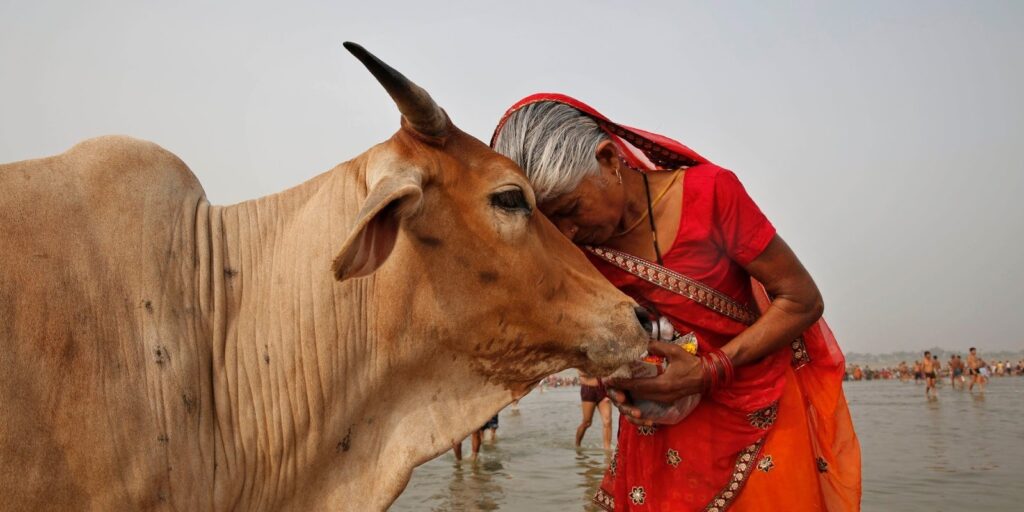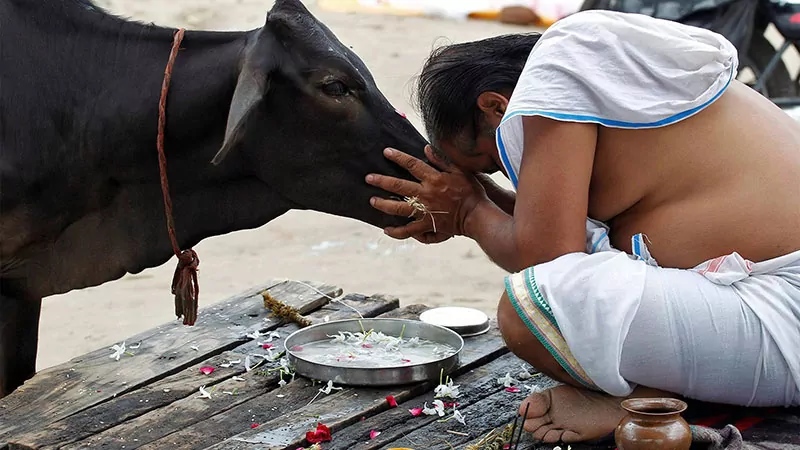Gau Mata : Why is the Cow Revered in India?
The cow has been deeply revered in India since ancient times. Hindu religious texts consider the cow as the mother of the universe popularly known as Gau Mata. The cow finds mention in all major Hindu scriptures like the Vedas, Puranas, Ramayana, Mahabharata, etc. The Vedas state that while all objects in the world, animate or inanimate, have elements of only one god, the cow has the essence of all gods and goddesses. The Puranas mention several divine cows like Kamadhenu, Nandini, Surabhi, Kapila, Subhadra and Bahula. These were different breeds of cows that existed in ancient times.

Ancient sages studied nature and animals in great detail. They found that the cow and its milk had unique characteristics and properties that were immensely useful for humans. Hence, the cow was accorded a sacred status. There are other reasons too that make the cow special compared to other animals.
The Vedas call the cow ‘aghnya’ meaning ‘not to be killed’. The cow was considered the most valuable possession of the Aryans. Cow urine contains ammonia which is antiseptic, while cow milk is closest to human mother’s milk. Hence, cow milk is recommended for infants as it has lactose that helps infants fight diseases. Cow milk has 87% water and 4% fat. It has less sugar, more salts and four times more casein, an important protein, than human milk. However, cow milk can vary based on breed, health of the cow and time between milkings. The last milk drawn in each milking is richer than the rest. Colostrum, the first milk, helps build the immune system. According to Indian scientists, the milk of red cows (Kapila) and black cows has different properties compared to white cow milk because red and black cows absorb sunlight differently which impacts milk quality.
Cow milk awakens and strengthens our innate pure and divine qualities while buffalo milk promotes inert and passionate tendencies. This is why gods preferred cow milk and products while demons and monsters favored buffalo milk. Cow calves can stay together happily but buffalo calves often quarrel, showing their demonic tendency. Aryans always took pride in owning cows while non-Aryans preferred buffaloes which produce more milk.
Cow milk, curd, ghee, dung and urine are all sacred. A combination of these five is called ‘panchagavya’ and is used to mitigate sins. The wood apple tree (Bel) seed, dear to Lord Shiva, is believed to be born of cow dung. This tree is the abode of Goddess Lakshmi and is called ‘shrivriksha’. Similarly, original seeds of blue and pink lotuses are born of cow dung. Gugal, an aromatic substance obtained from cow urine, is offered in sacred fires to please gods. Gorochan, a saffron substance obtained from cow horns, is used to write mantras. Everything obtained from the cow is sacred and suited to humans.
Nature designed the cow such that all its products are useful to humans. The cow’s skin absorbs sunlight sensitively. In olden days, cow dung was used to make a 4-inch boundary around houses to prevent diseases from entering living spaces during epidemics. Floors coated with cow dung paste remain free of germs as cow dung contains phosphorus, more effective than most disinfectants.
Cow urine is also a disinfectant and, if used carefully, can cure diseases. Hindu scriptures consider cow urine as sacred as the Ganges water. A Kanpur-based firm got a US patent for cow urine as medicine. Ayurveda describes many medical uses of cow urine. An old belief says cow dung in TB sanatoriums destroys TB germs and cleanses the place. Cow dung and urine cure many skin and blood disorders. Now, some ashrams make soaps and incense sticks from cow dung.
These facts about cows are scientific, not mythical. Observing cows grazing in jungles shows they choose vegetation good for humans. Even a cow’s anatomy suits human needs. The deep respect for cows in Sanatana Dharma emerges from both spiritual wisdom and scientific observation of their value for human well-being and spiritual progress.
The worship of Gau Mata is a way of worshipping God by appreciating one of His bountiful creations that provides humanity with numerous benefits.


Comments are closed.